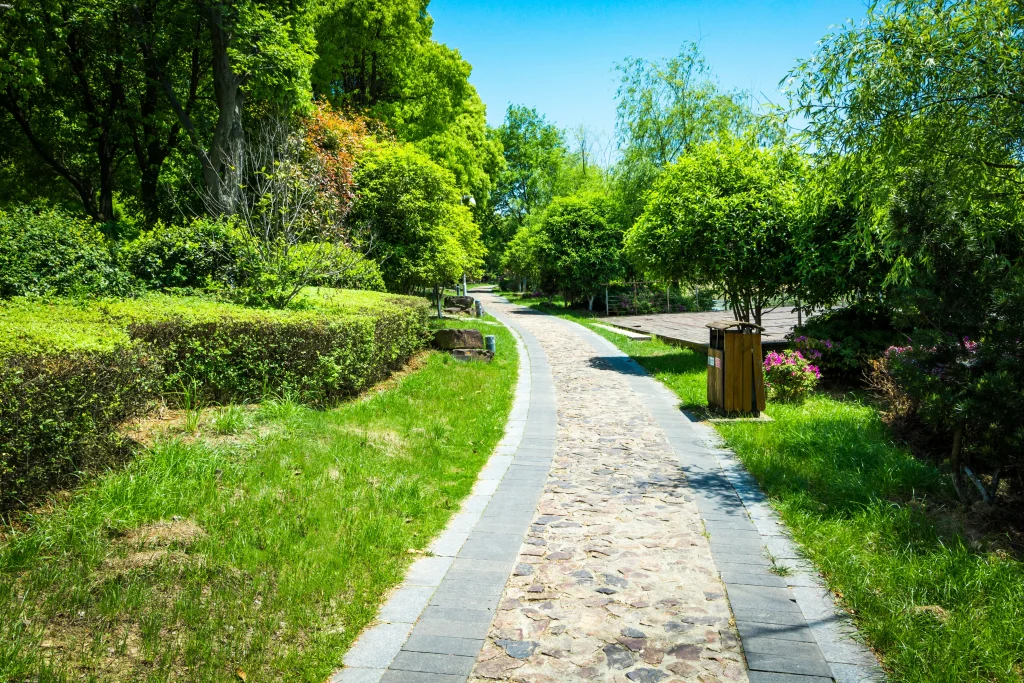An indoor zen rock garden transforms any corner of your home into a sanctuary of calm, merging centuries-old Japanese meditation practices with contemporary interior design.
Whether you’re settling into a cozy apartment, a suburban residence, or a studio, building a zen garden at home offers a powerful way to cultivate mindfulness and bring natural serenity indoors.
This comprehensive guide will walk you through everything you need to know:
- The ancient philosophy of Zen gardens
- Essential zen garden materials for your project
- Detailed instructions on how to make a zen rock garden from scratch
- Some inspiring design concepts for any living space
- Maintenance strategies
Read more about landscape rocks topic:
- Water-wise river rock flower beds: 15 creative designs for Denver gardens
- 10 modern black rock landscape ideas for Denver homes
- Front yard rock and mulch landscape pictures: 17 stunning Denver ideas
- Low-maintenance rock desert landscape: 18 ideas to transform your Denver yard
What is an indoor zen rock garden?
The philosophy of zen gardening
The art of creating a zen garden traces its roots to the Japanese “Karesansui” which means dry landscape gardens that Buddhist monks developed as meditation tools centuries ago.
These contemplative spaces embody 3 core principles: simplicity, balance, and the acceptance of impermanence. Each carefully placed rock represents a mountain or island. The raked sand or gravel symbolizes the flowing movement of water.
The practice of building a zen garden encourages us to slow down, be present, and appreciate the subtle beauty found in natural textures and organic forms.
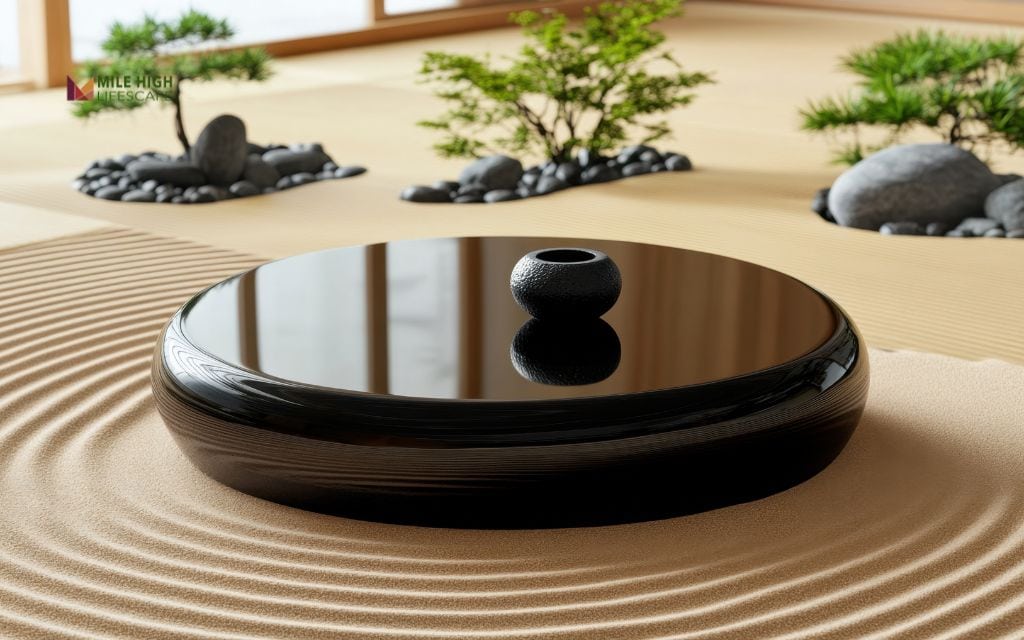
The modern adaptation
Today’s home zen garden has evolved from temple courtyards to fit into modern life.
These scaled-down versions utilize trays, decorative bowls, or tabletop displays that bring ancient wisdom into contemporary spaces.
Your indoor zen rock garden serves dual purposes: it’s both a striking design element and a functional meditation aid that merges wellness with aesthetic sophistication.
Benefits of an indoor zen rock garden
| Benefit | Why it matters |
| Stress relief | The repetitive motion of raking sand and arranging stones activates mindfulness, reducing anxiety and mental clutter. |
| Aesthetic harmony | Natural elements introduce organic beauty and visual balance to modern interiors, creating focal points that soothe rather than stimulate. |
| Improved air quality | When you incorporate moss or small plants, your garden helps purify indoor air while supporting feng shui energy principles. |
| Enhanced focus | Perfect for home offices or creative spaces, the zen garden with sand provides a mental reset that boosts concentration and problem-solving abilities. |
| Minimal maintenance | Your zen garden backyard or indoor version requires no watering schedules or sunlight concerns. |
Materials you’ll need for your indoor zen rock garden
Understanding the right zen garden materials ensures your DIY zen rock garden project succeeds from the start:
| Material | Purpose | Selection notes |
| Container or tray | Provides the foundation | Choose wood, bamboo, or ceramic; keep it shallow (2-4 inches) with slightly raised edges to contain materials. |
| Sand or fine gravel | Represents flowing water | Opt for fine white or beige sand, crushed granite, or smooth aquarium gravel depending on your aesthetic preference. |
| Stones and rocks | Symbolize mountains and islands | Select various sizes and textures – mixing smooth river rocks with rougher stones creates natural visual interest. |
| Miniature rake or brush | Creates meditative patterns | Purchase specialized Zen rakes online or craft your own using bamboo skewers and small combs. |
| Accent elements | Personalizes your space | Consider preserved moss, miniature bonsai, small crystals, candle holders, or incense burners. |
| Protective base | Safeguards furniture | Use felt pads or cork mats underneath to prevent surface scratches. |
Read more: Top 8 landscaping rock types for designing a Denver yard in Colorado’s climate
How to make an indoor zen rock garden (step-by-step guide)
Step 1: Choose your ideal location
Select a peaceful area with gentle, indirect natural light. Popular locations include desk corners, bedroom shelves, coffee tables, or dedicated meditation nooks. Avoid cluttered spaces or areas with direct sunlight, which can fade your sand and harm living elements like moss.
Step 2: Select your container
Your container choice sets the tone for your entire do it yourself zen garden:
- Wood or bamboo trays bring warmth and connect to traditional Japanese aesthetics
- Ceramic or concrete vessels complement modern minimalist interiors
- Compact travel trays (8-12 inches wide) work for office desks or small apartments
The container should feel substantial enough to ground your practice but proportionate to your available space.
Step 3: Add your sand or gravel foundation
Pour sand or fine gravel to a depth of 1-2 inches, creating an even base layer. This becomes your canvas for meditation and creative expression. Smooth the surface carefully – the quality of this foundation affects how well your rake creates clean, satisfying patterns.
Step 4: Arrange rocks with intention
How do you make a zen garden feel authentic? The secret lies in mindful rock placement:
- Use odd-numbered groupings (3, 5, or 7 stones) to mirror nature’s asymmetrical beauty
- Position one larger stone as a focal point, representing a dominant mountain or central island
- Embrace imperfection
- Leave negative space around rocks to maintain visual breathing room
This arrangement is about finding balance that feels right to your eye and spirit.
Step 5: Rake patterns to represent water flow
Using your miniature rake, draw circular ripples, gentle waves, or straight lines that suggest water currents around your stones. The act of raking itself becomes a moving meditation. Feel free to erase and redesign frequently; impermanence is central to the practice.
Step 6: Personalize your garden
Complete your zen garden backyard or indoor version with meaningful touches:
- Miniature figurines or small Buddha statues for symbolic depth
- Preserved moss for texture and natural color
- LED tea lights or small candles for evening meditation
- Incense holders for aromatic elements
- Polished crystals or meaningful small objects
While creating a zen garden, consider playing ambient sounds – flowing water, wind chimes, or traditional Japanese flute music – to deepen your meditative experience.
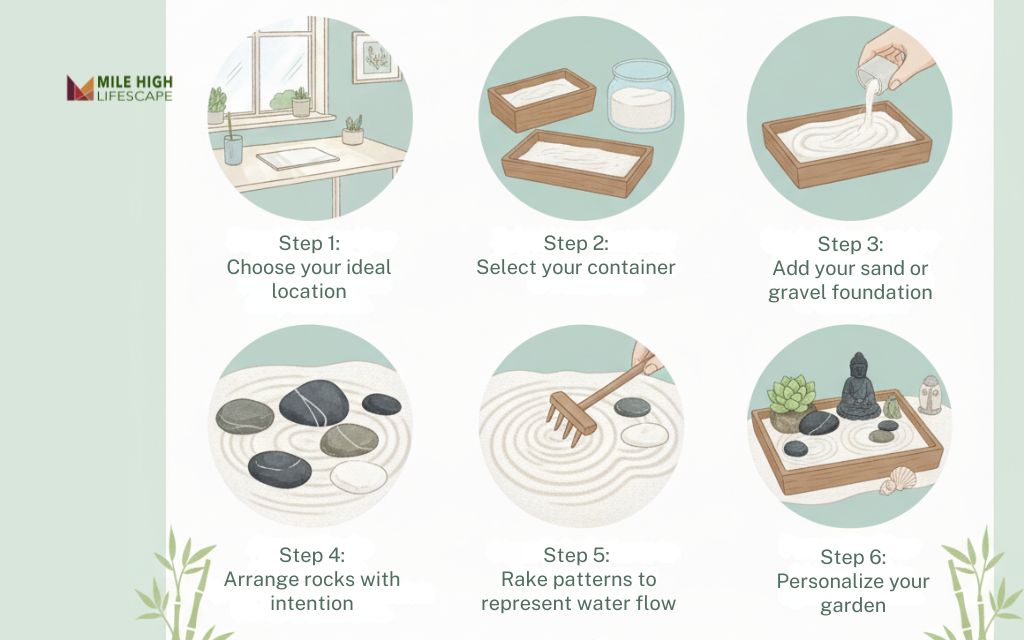
7 creative indoor zen garden ideas for every space
Desktop zen garden
Perfect for home offices, a compact tray (6-10 inches) provides stress relief during work breaks. Keep it simple with fine sand, 3 smooth stones, and a small rake within arm’s reach.
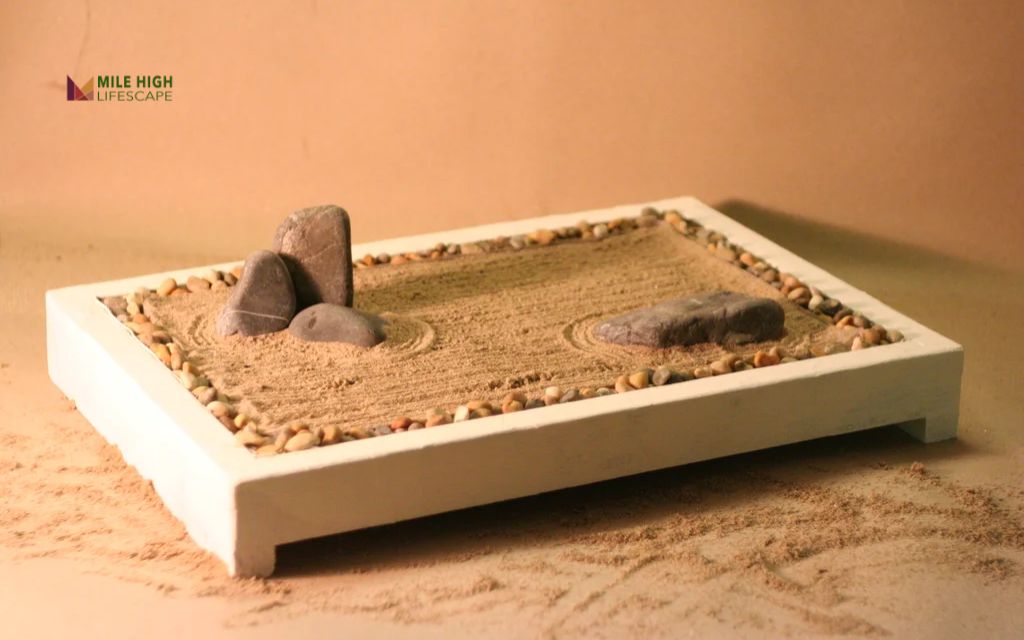
Terrarium zen garden
Combine rocks, live moss, and miniature succulents inside a glass bowl or terrarium. This living version of the traditional zen garden with sand adds humidity and greenery to your space.
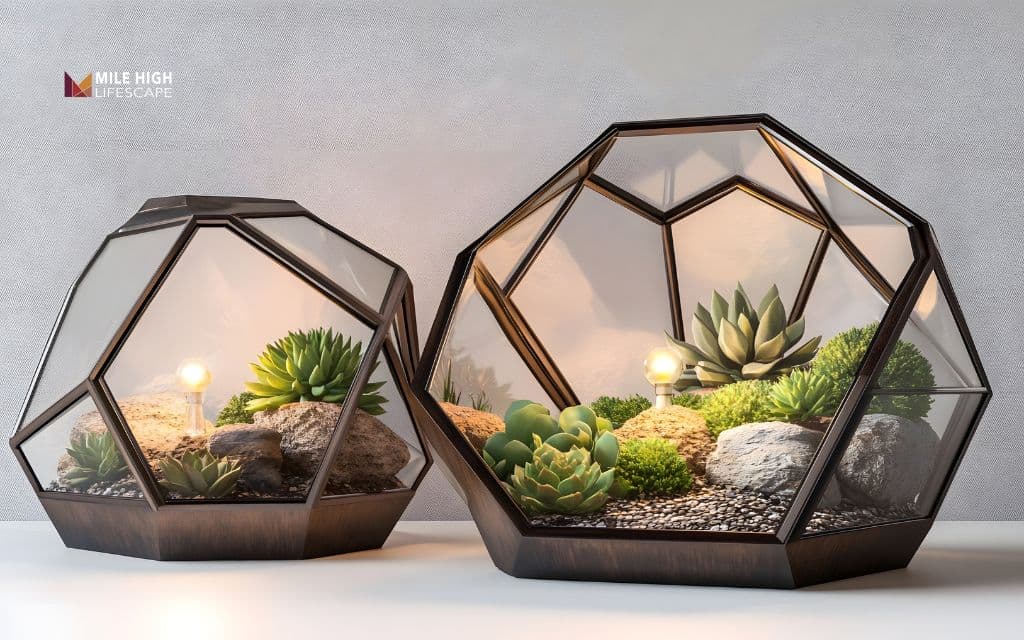
Minimalist sand tray
Honor pure simplicity: white sand, three carefully chosen stones, and soft lighting. Ideal for dedicated meditation corners where distractions should be minimal.
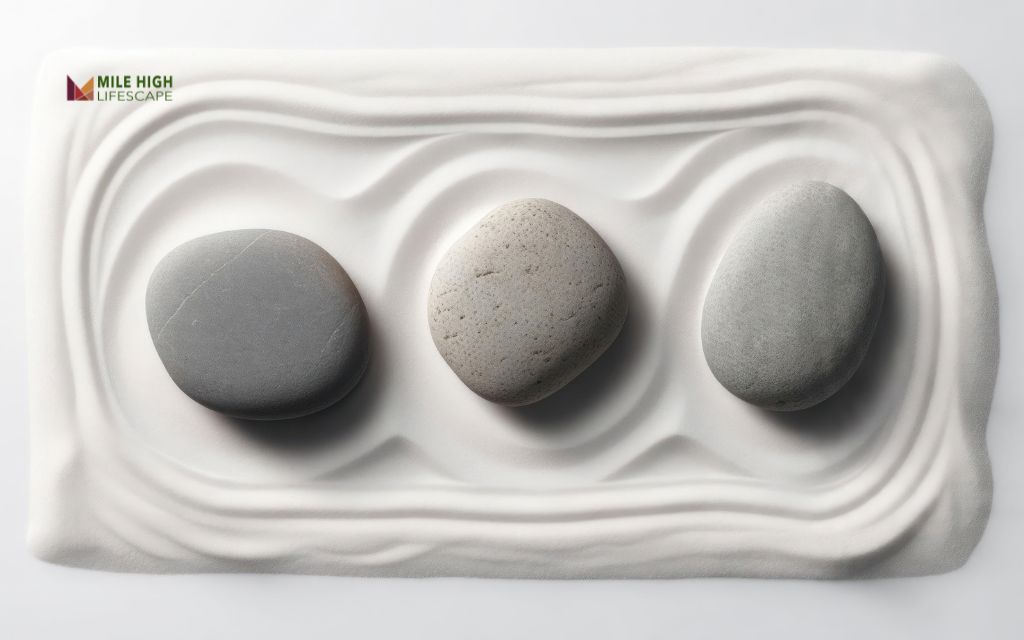
Zen coffee table centerpiece
Use a long, narrow wooden tray filled with white or gray gravel and natural driftwood pieces. This becomes a calming living room focal point that guests will admire.
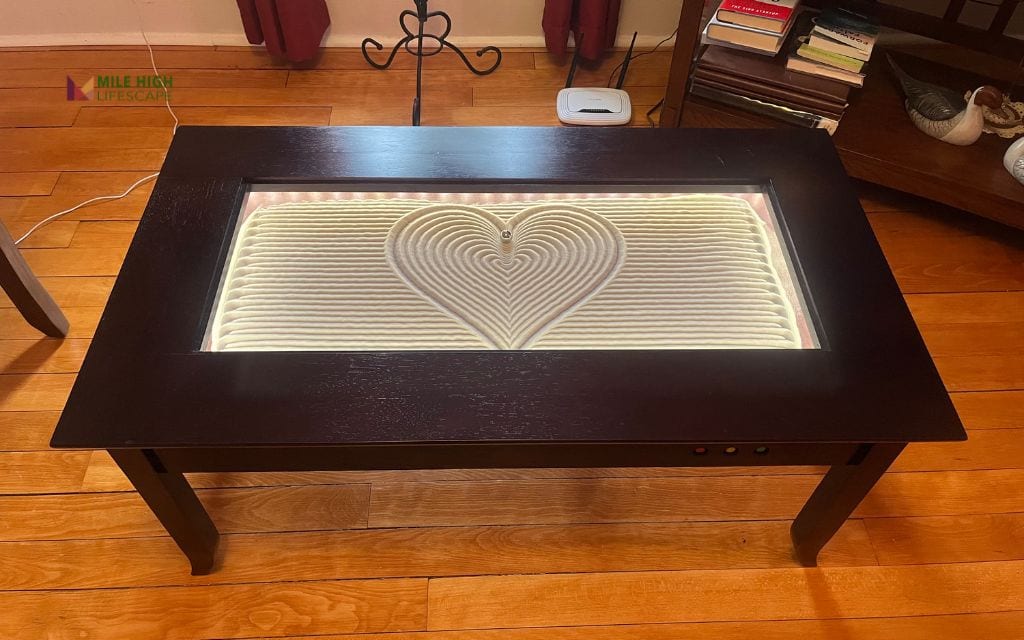
Candlelit zen nook
Transform a corner with votive candles, bamboo placement mats, and your zen garden backyard ideas adapted for indoor use. Perfect for evening meditation or winding down before sleep.
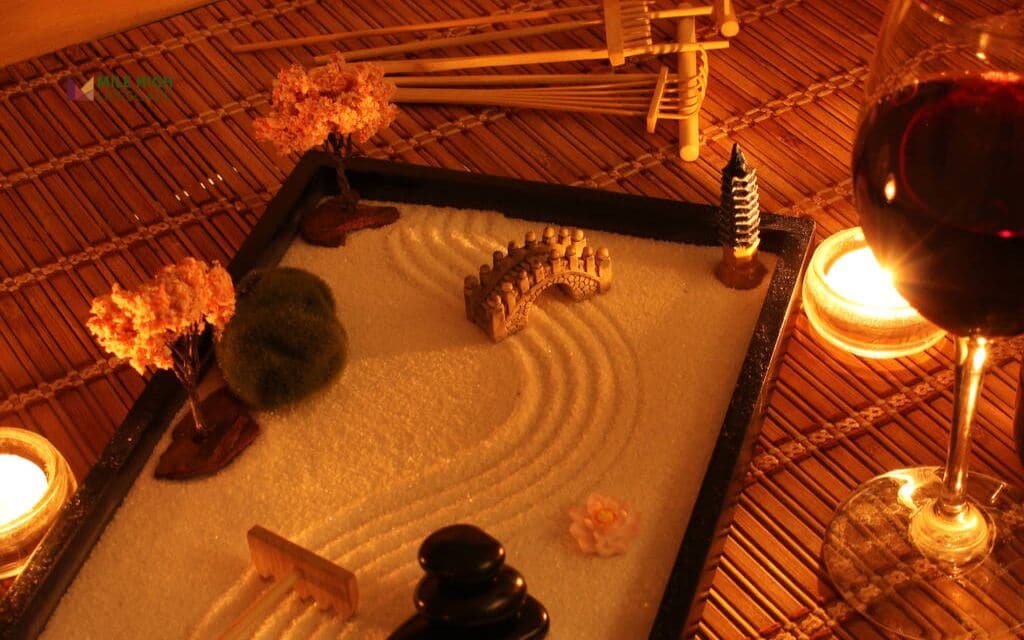
Wall-mounted zen display
Install shallow shadow boxes at eye level, filling them with sand and small stones. This vertical approach works wonderfully in apartments where surface space is limited.
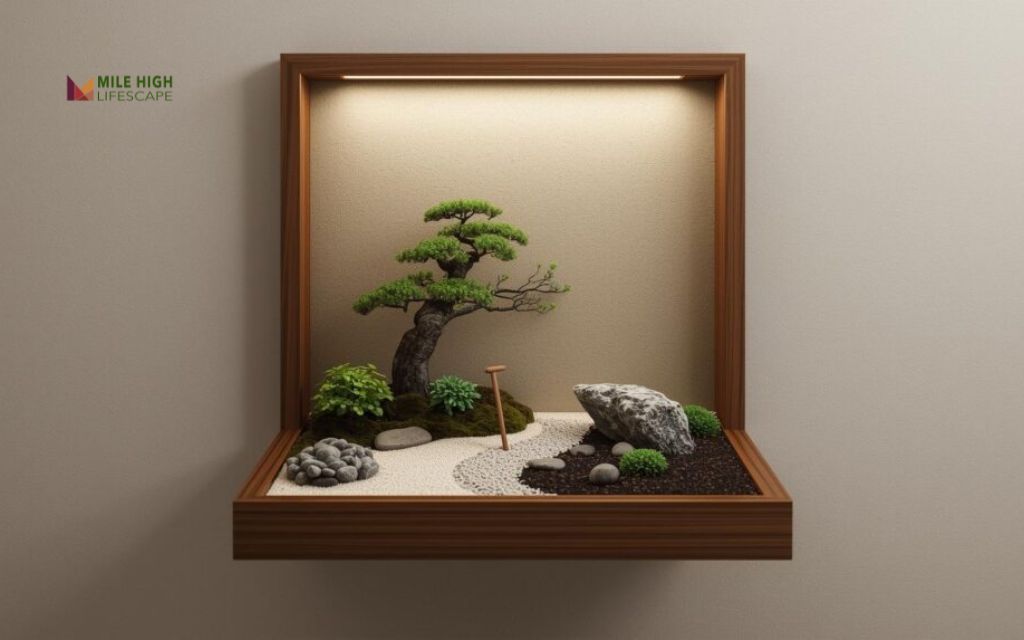
Botanical zen garden
Merge traditional and contemporary by pairing air plants, miniature bonsai, or small ferns with pebbles and sand. This living adaptation honors the dry garden tradition while introducing natural growth.
Read more: 23 zen rock garden ideas to create your backyard meditation oasis (water-wise & beautiful)
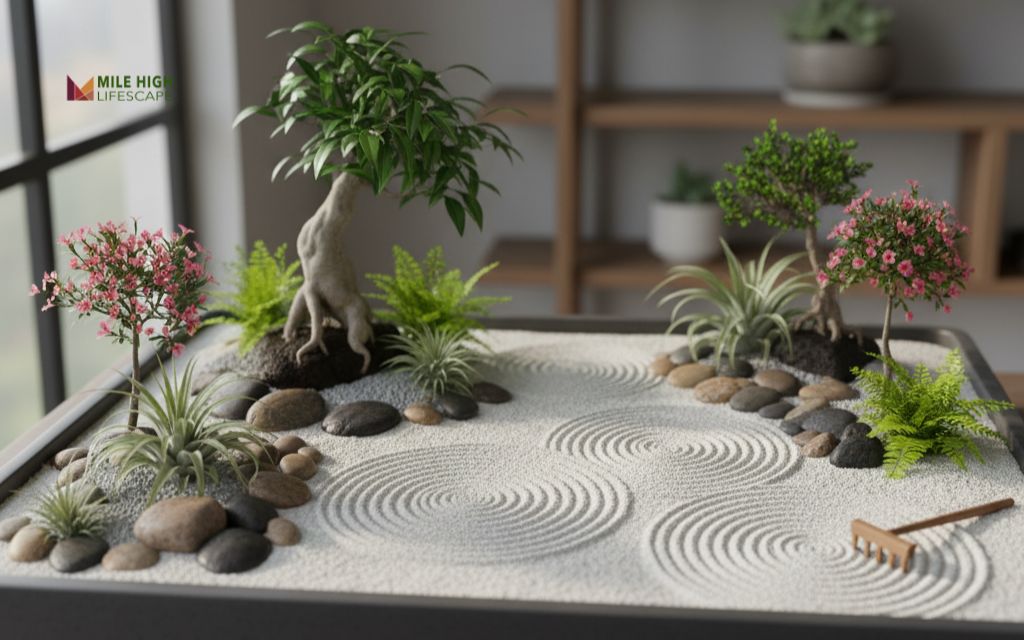
Using your zen garden for mindfulness and meditation
Begin with clear intention
Sit comfortably before your garden. Take three deep breaths, allowing your shoulders to drop and your mind to settle. Focus entirely on the tactile sensation of the rake moving through sand and the soft sound it creates.
Embrace the impermanent nature
Erase your patterns regularly and start fresh. This practice reinforces one of Zen Buddhism’s core teachings. Each new design reflects your current state of mind, creating a visual diary of your inner landscape.
Incorporate aromatherapy
Light natural incense such as lavender for relaxation, sandalwood for grounding, or cedar for clarity. Engaging multiple senses transforms your practice from visual to fully immersive.
Establish a daily ritual
Dedicate just 5 minutes each morning to adjusting stones or tracing new patterns before beginning your workday. This simple practice can significantly impact your mental clarity and emotional resilience throughout the day.
Maintenance tips for long-lasting tranquility
Keeping your indoor zen rock garden fresh requires minimal effort:
- Weekly dusting: Use a soft brush to remove accumulated dust from sand and stones
- Sand replacement: Refresh your sand or gravel every 6-12 months to maintain color and texture
- Stone cleaning: Wipe rocks periodically with a slightly damp cloth to preserve their natural luster
- Plant care: If using moss or living elements, mist lightly
- Protection from elements: Store away from curious pets and open windows (Denver’s winds can scatter sand!)
- Rake maintenance: Clean your rake to prevent buildup that affects pattern quality
Conclusion
Creating your indoor zen rock garden transcends simple home décor. It’s an invitation to cultivate stillness, practice mindfulness, and reconnect with natural simplicity in our often chaotic modern world.
Whether you follow these instructions to build a zen garden from scratch or purchase a pre-assembled kit to customize, this small sanctuary will infuse your daily life with Japanese-inspired serenity and contemplative beauty.
_______________
Need Expert Rock Selection Guidance?
Mile High Lifescape has provided premium landscaping rock services in Denver, specializing in outdoor garden design and installation. While our primary focus is creating beautiful landscape features – patios, pathways, water features, and garden beds – we’re always happy to consult with homeowners on rock selection for any project, including indoor zen gardens.
Whether you need stones for your meditation space or planning a backyard landscape transformation, our team can guide you in choosing the right materials that complement Colorado’s climate and your design vision.
Need consultation on rocks and materials? Call Mile High Lifescape: (303) 877-9091
Frequently asked questions (FAQ)
What kind of sand is best for a zen rock garden?
Fine white or beige sand works beautifully for traditional aesthetics. Alternatively, decomposed granite offers a natural earth tone, while play sand provides easy accessibility and affordable pricing.
Do I need live plants in my zen garden?
Not at all. Authentic Zen gardens are “dry landscapes” without living elements. However, preserved moss, air plants, or miniature bonsai can enhance the calming atmosphere if you prefer a living touch.
How big should my zen garden be?
Size matters far less than intention. Your garden can range from a compact 6-inch desktop tray to an expansive 3-foot coffee table installation. Choose dimensions that fit your space and commitment level.
Can I use aquarium gravel instead of sand?
Absolutely! Aquarium gravel offers excellent drainage, creates no dust, and is easier to maintain than sand. It’s an ideal choice for beginners or those with dust sensitivities.
Is a zen garden the same as feng shui?
While both practices share harmony and balance principles, they serve different purposes. Zen gardens focus primarily on meditation and mindfulness practice, whereas feng shui emphasizes energy flow and environmental arrangement for overall wellbeing.
